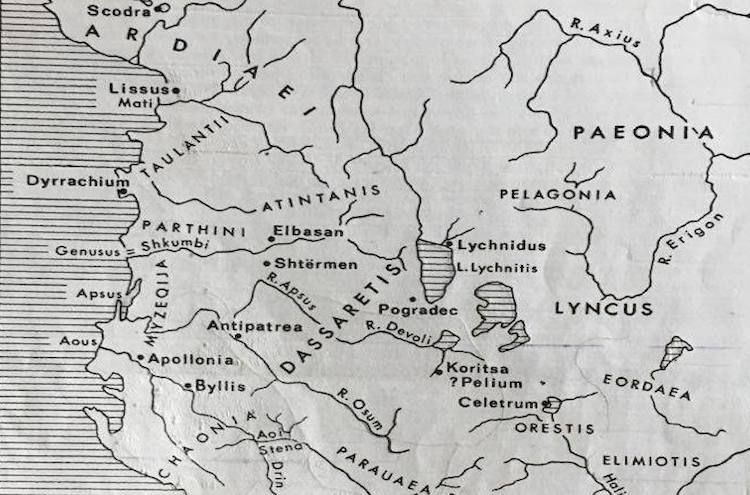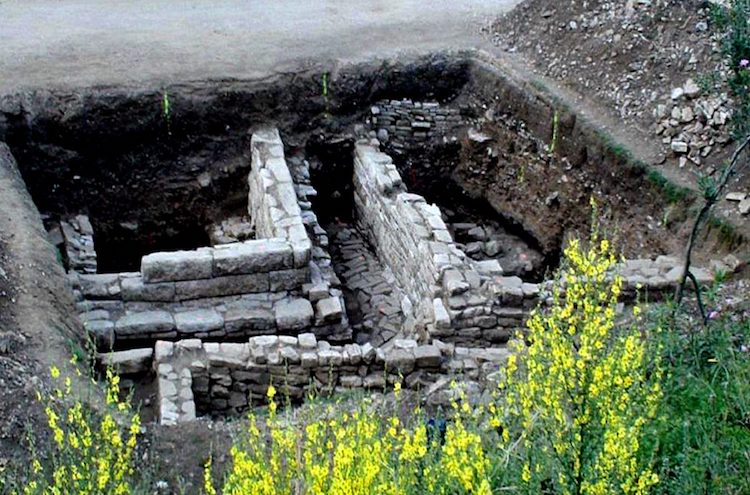
Illyrian Kings: A Handbook on Illyrian Monarchy; Main Rulers and Dynasties.
Illyrian kings are mentioned in few literal sources, even those written by ancient Greek and Roman authors, thus external and often hostile to Illyrians. As such, their names come up only in events concerning the Hellenes or Romans themselves. The absence of written records in Illyrian language (recognized as a spoken language) leaves inherent gaps in political developments that would otherwise be less obscure.
Geographical Consideration
The extent of the realm of Illyrian kings is unclear in detail. This is mainly because the Illyrians were a society organized in many tribes and tribal identity prevailed over an “Illyrian” identity.
The Illyrian tribes collectively covered a large area in antiquity, from the Istrian peninsula north into the hinterland facing Corfu island south. The Adriatic and Ionian Sea marked their western border with strategic places along the shore occupied by Hellenic colonies. Eastwards, they stretched as far as the Struma valley narrowing south into the extended Pindus range.

However, an Illyrian tribe only covered a specific portion of the aforementioned large area. Thus, the realm of a certain Illyrian ruler covered mainly that of his tribe, however, there are records of Illyrian rulers stretching their dominance over other neighboring tribes but no records of an Illyrian king ruling over entire Illyria (so-called collectively the lands inhabited by all known, different, Illyrian tribes.
The Terminology of “Illyrian Kings”
Thus, when classical authors called an Illyrian ruler “king of the Illyrians” they were using the term “Illyrians” here mostly in a general sense to indicate that the certain king ruled over some Illyrian tribes, and not in a specific sense. Also, since the term king applies to a political unit, namely a kingdom, it follows that the political entity called “kingdom of Illyria” varied in time and space.
There are no records of one kingdom of Illyria including all Illyrian tribes, rather, different clusters of Illyrian kingdoms each ruling some Illyrian tribes. Whether the Illyrian kings called themselves “king of the Illyrians” or “king of Illyria” is unclear. To the ancient Illyrian ruler this would seem semantics. What must have mattered for them was holding the leadership of their specific Illyrian tribe and extending the dominance of their tribe into other neighboring Illyrian tribes.
A change in officially assuming the title “king of the Illyrians” must have occurred only during Hellenistic time, in the fashion of the Diadochi. These seem to have been the cases of the rulers of the Ardiaei, those of Paeonia, and the kings of the Taulantii during the III-rd century, Monunius and Mytilius.
The Main Dynasties Among Illyrians
In the absence of a unified Illyrian kingdom, different kingdoms of Illyrian tribes (referred for simplicity as “Illyrian kingdoms”) or Illyrian ruling dynasties appeared along Illyria. One of the oldest Illyrian monarchies took shape around Lake Lychnidus (Lake Ohrid) and the Lyncestian Lakes (Prespa Lakes).
The Encheleians/Encheleii
The area round Lake Lychnidus was inhabited by the Illyrian tribe of the Enchelei. Thus, the state built around them can also be referred to as the dynasty of the Enchelei. The chronology is highly problematic (even approximate ruling times), but from available evidence, we can construct the following line of rule:
Sirras – apparently ruler of the Lyncestae, an Illyrian-Macedonian tribe who was in ruling position in 430 B.C.E.
Bardylis I (448-357; r. 395-357) – apparently a member of the Enchelei who must have first emerged as the leader of his tribe and then usurped the throne of Sirras as well. He was a powerful Illyrian king who established the earliest multi tribal Illyrian kingdom.
Grabus (r. 357-?) – a ruler of the Grabaei, a tribe neighbouring the Encheleii. After Bardylis’ rule and Philip’s defeat of his forces, he may have incorporated into his domain the remaining lands of the Encheleii.
Cleitus (r. ?-335) – apparently son of Bardylis (although no classical source specifies so). In alliance with another Illyrian ruler, Glaucias, fought against Alexander the Great.
The Taulantii
With Cleitus falls the line of the Enchelei. The power center shifts somewhat east, in the lands of the Taulantii, corresponding to current central Albania. The following is what we can establish from the Illyrian kingdom of the Taulantii:
Glaucias (r. 335-302) – Established an important and strong Illyrian kingdom in current Central Albania. He is known for sheltering and adopting the infant Pyrrhus of Epirus.
Bardylis (II) the Younger (r.302- ?) – succeeded Glaucias and may have remained politically active until 284-282.
Monunius I (r. 290-272) – Exercised control over the powerful coastal colonies of Dyrrachium and Apollonia. Minted his own coins.
Pyrrhus of Epirus – invaded and ruled, at least formally, the lands of the Taulantii during 275-272. He was the adoptive son of the former king Glaucias.
Mytilus – (r. 272-260). Liberated the Taulantii from the Epirote rule.

The Ardiaeii
The other most notable dynastic rule flourished among the Illyrian tribe of the Ardiaeii. They seem to have expanded south from the hinterland of the Neretva River and relatively quickly subdued other tribes. They formed the Illyrian kingdom that is famous for its seafaring tradition and wars against the Romans.

The following are the Ardiaean rulers known to us:
Pleuratus I (r. 345-310) – An earlier king of the Ardiaeii who fought against Philip.
Ballaios (r. 310 ?-280 ?) – He is known only for coins bearing his name. His domain’s capital was apparently in Rhizon (Risan), a naturally protected bay suitable for naval ambitions and progress.
Pleuratus II (r. 280-250) – Father of Agron who seems to have developed the maritime power of his Illyrians.
Agron (r. 250-231) – Succeeded Pleuratus inheriting a very strong kingdom.
Teuta (r. 231-228) – Wife of Agron who took power after him in the name of son and successor Pinnes. The latter was not Teuta’s son but rather son of Agron and his other wife Triteuta.
Pinnes (r. 228-218) – Young king who had to pay tribute to the Romans and obey the rules imposed by the Roman Republic.
Demetrius of Pharos (r.228-219) – Ruled as regent king on behalf of infant Pinnes by marrying his mother Triteuta and acting as a vassal of the Romans.
Scerdilaidas (r. 218-206) – Adept Illyrian commander, apparently brother of previous king Agron.
Pleuratus III (r. 206-181) – son of Scerdilaidas who married Eurydice (Livy XLIV. 30.).
Gentius (r. 181-168) – son and successor of Pleuratus. Abandoned the pro-Roman policy of his father and fought against Rome. His defeat marks the conquest of the Ardiaeian realm by the Romans.
Pleuratus IV and Plator – sons of Gentius who, as their father, became prisoners of Rome after the Third Illyrian War. Thus, unable to rule over the Illyrians.

Other Aspects on Illyrian Kings
As presented above, the Illyrian monarchy was hereditary although there were some expectations based on specific political circumstances. The Illyrian kings seems to have also been polygamous. Women enjoyed a way more privileged status than women across Greece and even Macedon. Even though the Illyrian kings ruled over a monarchy not all of Illyria reflected monarchical states.
Apart from the colonies of Dyrrachium and Apollonia that were self-governed, Republican leagues were formed especially in southern Illyrian such as those of the Atintati, Bylines, Amantes, and that around Buthrotum. These constituencies were at times included within a certain Illyrian kingdom but kept a high degree of internal governing autonomy.

Bibliography
Dyczek, P. (2013). Illyrian Kings Ballaios, Agron and Queen Teuta from Ancient Rhizon. Anodos. Studies of the Ancient World.
Hammond, N.G.L. The Kingdoms in Illyria Circa 400-167.
Hammond, N.G.L. (1966). The Opening Campaigns and the Battle of the Aoi Stena in the Second Macedonian War. The Journal of Roman Studies, Vol. 56, Parts 1 and 2, pp. 39-54.
McPherson, C.A. (2012). The First Illyrian War: A Study in Roman Imperialism. Library and Archives Canada = Bibliothèque et Archives Canada.
Velija, Q. (2012). Mbretëri dhe Mbretër Ilirë. West Print.
Walbank, F.W. (1976). Southern Illyria in the third and second centuries B.C. Iliria, Nr. 4, pp. 265-272.
Wilkes, J. (1992). Ilirët (Illyrians). Bacchus, Tirana-Albania, 2005.








